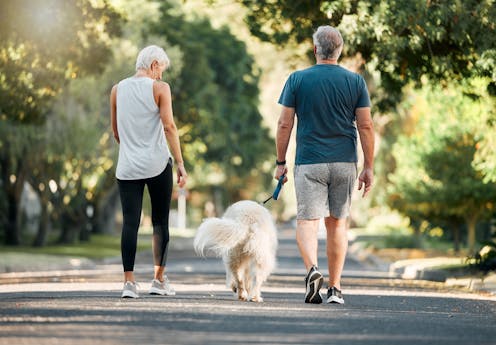Walking can prevent low back pain, a new study shows
- Written by Tash Pocovi, Postdoctoral research fellow, Department of Health Sciences, Macquarie University

Do you suffer from low back pain that recurs regularly? If you do, you’re not alone. Roughly 70% of people[1] who recover from an episode of low back pain will experience a new episode in the following year.
The recurrent nature of low back pain is a major contributor to the enormous burden[2] low back pain places on individuals and the health-care system.
In our new study, published today in The Lancet[3], we found that a program combining walking and education can effectively reduce the recurrence of low back pain.
The WalkBack trial
We randomly assigned 701 adults who had recently recovered from an episode of low back pain to receive an individualised walking program and education (intervention), or to a no treatment group (control).
Participants in the intervention group were guided by physiotherapists across six sessions, over a six-month period. In the first, third and fifth sessions, the physiotherapist helped each participant to develop a personalised and progressive walking program that was realistic and tailored to their specific needs and preferences.
The remaining sessions were short check-ins (typically less than 15 minutes) to monitor progress and troubleshoot any potential barriers to engagement with the walking program. Due to the COVID pandemic, most participants received the entire intervention via telehealth, using video consultations and phone calls.
The program was designed to be manageable, with a target of five walks per week of roughly 30 minutes daily by the end of the six-month program. Participants were also encouraged to continue walking independently after the program.
Importantly, the walking program was combined with education provided by the physiotherapists during the six sessions. This education aimed to give people a better understanding of pain, reduce fear associated with exercise and movement, and give people the confidence to self-manage any minor recurrences if they occurred.
People in the control group received no preventative treatment or education. This reflects what typically occurs[5] after people recover from an episode of low back pain and are discharged from care.
What the results showed
We monitored the participants monthly from the time they were enrolled in the study, for up to three years, to collect information about any new recurrences of low back pain they may have experienced. We also asked participants to report on any costs related to their back pain, including time off work and the use of health-care services.
The intervention reduced the risk of a recurrence of low back pain that limited daily activity by 28%, while the recurrence of low back pain leading participants to seek care from a health professional decreased by 43%.
Participants who received the intervention had a longer average period before they had a recurrence, with a median of 208 days pain-free, compared to 112 days in the control group.
Overall, we also found this intervention to be cost-effective. The biggest savings came from less work absenteeism and less health service use (such as physiotherapy and massage) among the intervention group.
This trial, like all studies, had some limitations to consider. Although we tried to recruit a wide sample, we found that most participants were female, aged between 43 and 66, and were generally well educated. This may limit the extent to which we can generalise our findings.
Also, in this trial, we used physiotherapists who were up-skilled in health coaching. So we don’t know whether the intervention would achieve the same impact if it were to be delivered by other clinicians.
Walking has multiple benefits
We’ve all heard the saying that “prevention is better than a cure” – and it’s true. But this approach has been largely neglected when it comes to low back pain. Almost all previous studies[7] have focused on treating episodes of pain, not preventing future back pain.
A limited number of small studies[8] have shown that exercise and education can help prevent low back pain. However, most of these studies focused on exercises that are not accessible to everyone due to factors such as high cost, complexity, and the need for supervision from health-care or fitness professionals.
On the other hand, walking is a free, accessible way to exercise, including for people in rural and remote areas with limited access to health care.
Walking also delivers many other health benefits[10], including better heart health, improved mood and sleep quality, and reduced risk of several chronic diseases.
While walking is not everyone’s favourite form of exercise, the intervention was well-received by most people in our study. Participants reported[11] that the additional general health benefits contributed to their ongoing motivation to continue the walking program independently.
Why is walking helpful for low back pain?
We don’t know exactly why walking is effective for preventing back pain, but possible reasons[12] could include the combination of gentle movements, loading and strengthening of the spinal structures and muscles. It also could be related to relaxation and stress relief, and the release of “feel-good” endorphins, which block pain signals[13] between your body and brain – essentially turning down the dial on pain.
It’s possible that other accessible and low-cost forms of exercise, such as swimming, may also be effective in preventing back pain, but surprisingly, no studies[14] have investigated this.
Preventing low back pain is not easy. But these findings give us hope that we are getting closer to a solution, one step at a time.
References
- ^ 70% of people (pubmed.ncbi.nlm.nih.gov)
- ^ enormous burden (www.thelancet.com)
- ^ The Lancet (www.thelancet.com)
- ^ Karolina Kaboompics/Pexels (www.pexels.com)
- ^ typically occurs (www.sciencedirect.com)
- ^ PeopleImages.com - Yuri A/Shutterstock (www.shutterstock.com)
- ^ previous studies (www.sciencedirect.com)
- ^ small studies (pubmed.ncbi.nlm.nih.gov)
- ^ Cast Of Thousands/Shutterstock (www.shutterstock.com)
- ^ health benefits (www.vichealth.vic.gov.au)
- ^ reported (pubmed.ncbi.nlm.nih.gov)
- ^ possible reasons (www.e-jer.org)
- ^ block pain signals (my.clevelandclinic.org)
- ^ no studies (pubmed.ncbi.nlm.nih.gov)
Read more https://theconversation.com/walking-can-prevent-low-back-pain-a-new-study-shows-231682
















